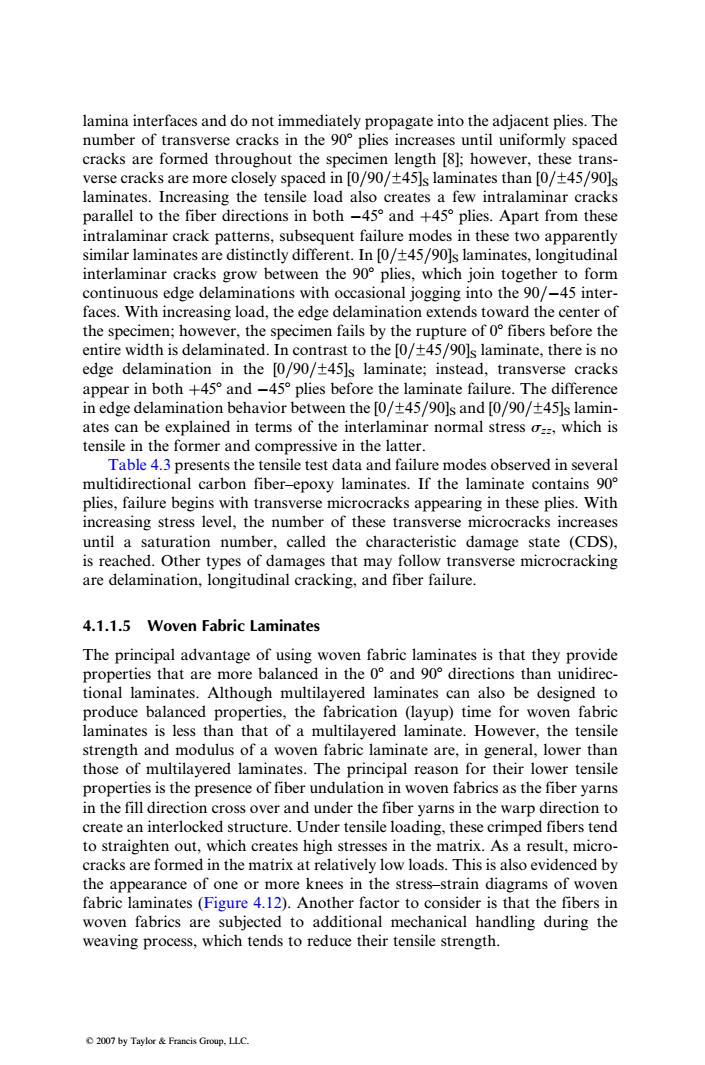正在加载图片...

lamina interfaces and do not immediately propagate into the adjacent plies.The number of transverse cracks in the 90 plies increases until uniformly spaced cracks are formed throughout the specimen length [8];however,these trans- verse cracks are more closely spaced in [0/90/+45]s laminates than [0/+45/90]s laminates.Increasing the tensile load also creates a few intralaminar cracks parallel to the fiber directions in both-45 and +45 plies.Apart from these intralaminar crack patterns,subsequent failure modes in these two apparently similar laminates are distinctly different.In [0/+45/90]s laminates,longitudinal interlaminar cracks grow between the 90 plies,which join together to form continuous edge delaminations with occasional jogging into the 90/-45 inter- faces.With increasing load,the edge delamination extends toward the center of the specimen;however,the specimen fails by the rupture of o fibers before the entire width is delaminated.In contrast to the [0/+45/90]s laminate,there is no edge delamination in the [0/90/+45]s laminate;instead,transverse cracks appear in both +45 and-45 plies before the laminate failure.The difference in edge delamination behavior between the [0/+45/90]s and [0/90/+45]s lamin- ates can be explained in terms of the interlaminar normal stress o=,which is tensile in the former and compressive in the latter. Table 4.3 presents the tensile test data and failure modes observed in several multidirectional carbon fiber-epoxy laminates.If the laminate contains 90 plies,failure begins with transverse microcracks appearing in these plies.With increasing stress level,the number of these transverse microcracks increases until a saturation number,called the characteristic damage state (CDS), is reached.Other types of damages that may follow transverse microcracking are delamination,longitudinal cracking,and fiber failure. 4.1.1.5 Woven Fabric Laminates The principal advantage of using woven fabric laminates is that they provide properties that are more balanced in the 0 and 90 directions than unidirec- tional laminates.Although multilayered laminates can also be designed to produce balanced properties,the fabrication (layup)time for woven fabric laminates is less than that of a multilayered laminate.However,the tensile strength and modulus of a woven fabric laminate are,in general,lower than those of multilayered laminates.The principal reason for their lower tensile properties is the presence of fiber undulation in woven fabrics as the fiber yarns in the fill direction cross over and under the fiber yarns in the warp direction to create an interlocked structure.Under tensile loading,these crimped fibers tend to straighten out,which creates high stresses in the matrix.As a result,micro- cracks are formed in the matrix at relatively low loads.This is also evidenced by the appearance of one or more knees in the stress-strain diagrams of woven fabric laminates(Figure 4.12).Another factor to consider is that the fibers in woven fabrics are subjected to additional mechanical handling during the weaving process,which tends to reduce their tensile strength. 2007 by Taylor Francis Group.LLC.lamina interfaces and do not immediately propagate into the adjacent plies. The number of transverse cracks in the 908 plies increases until uniformly spaced cracks are formed throughout the specimen length [8]; however, these transverse cracks are more closely spaced in [0=90=±45]S laminates than [0=±45=90]S laminates. Increasing the tensile load also creates a few intralaminar cracks parallel to the fiber directions in both 458 and þ458 plies. Apart from these intralaminar crack patterns, subsequent failure modes in these two apparently similar laminates are distinctly different. In [0=±45=90]S laminates, longitudinal interlaminar cracks grow between the 908 plies, which join together to form continuous edge delaminations with occasional jogging into the 90=45 interfaces. With increasing load, the edge delamination extends toward the center of the specimen; however, the specimen fails by the rupture of 08 fibers before the entire width is delaminated. In contrast to the [0=±45=90]S laminate, there is no edge delamination in the [0=90=±45]S laminate; instead, transverse cracks appear in both þ458 and 458 plies before the laminate failure. The difference in edge delamination behavior between the [0=±45=90]S and [0=90=±45]S laminates can be explained in terms of the interlaminar normal stress szz, which is tensile in the former and compressive in the latter. Table 4.3 presents the tensile test data and failure modes observed in several multidirectional carbon fiber–epoxy laminates. If the laminate contains 908 plies, failure begins with transverse microcracks appearing in these plies. With increasing stress level, the number of these transverse microcracks increases until a saturation number, called the characteristic damage state (CDS), is reached. Other types of damages that may follow transverse microcracking are delamination, longitudinal cracking, and fiber failure. 4.1.1.5 Woven Fabric Laminates The principal advantage of using woven fabric laminates is that they provide properties that are more balanced in the 08 and 908 directions than unidirectional laminates. Although multilayered laminates can also be designed to produce balanced properties, the fabrication (layup) time for woven fabric laminates is less than that of a multilayered laminate. However, the tensile strength and modulus of a woven fabric laminate are, in general, lower than those of multilayered laminates. The principal reason for their lower tensile properties is the presence of fiber undulation in woven fabrics as the fiber yarns in the fill direction cross over and under the fiber yarns in the warp direction to create an interlocked structure. Under tensile loading, these crimped fibers tend to straighten out, which creates high stresses in the matrix. As a result, microcracks are formed in the matrix at relatively low loads. This is also evidenced by the appearance of one or more knees in the stress–strain diagrams of woven fabric laminates (Figure 4.12). Another factor to consider is that the fibers in woven fabrics are subjected to additional mechanical handling during the weaving process, which tends to reduce their tensile strength. 2007 by Taylor & Francis Group, LLC.���